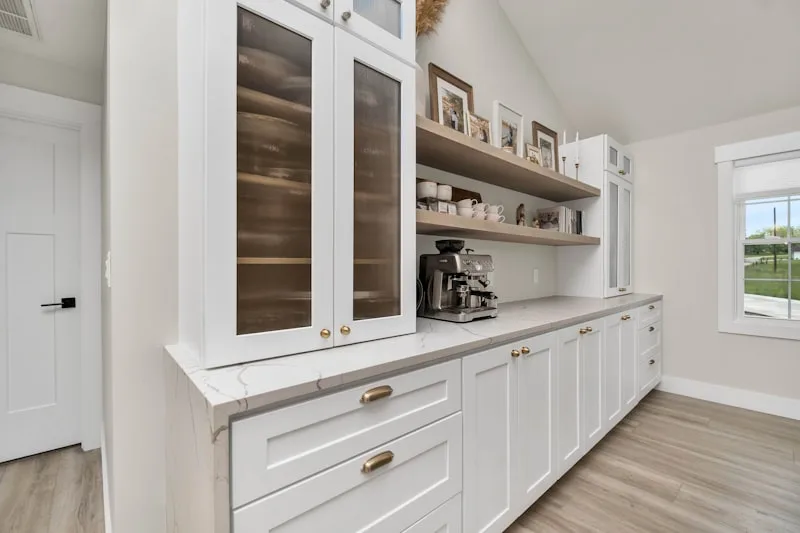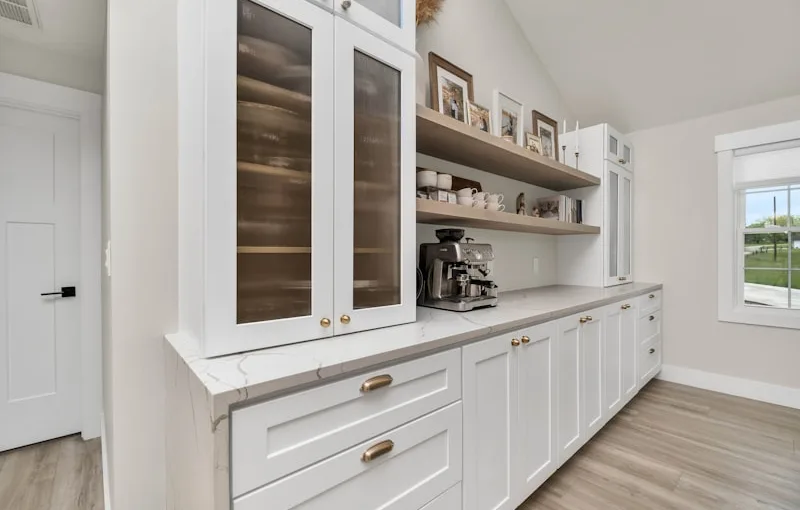First off, you want to gather your supplies. Think of it as assembling your cleaning dream team: a soft microfiber cloth, a gentle dish soap, and some warm water. Avoid harsh chemicals like bleach or ammonia; they’re like the bull in a china shop when it comes to wood finishes.
Start by dusting off your cabinets. Just like you wouldn’t serve a meal on a dirty plate, you don’t want to clean grime over dust. A quick wipe with a dry cloth will do the trick. Now, mix a few drops of dish soap into a bowl of warm water. It’s like creating a magic potion for your cabinets!
Dampen your microfiber cloth in the soapy water, but make sure it’s not soaking wet. You want it to be like a sponge that’s been wrung out—just enough moisture to clean without saturating the wood. Gently wipe down the surfaces, following the grain of the wood. Think of it as giving your cabinets a gentle massage; they’ll thank you for it!
For stubborn spots, a little extra elbow grease might be needed, but remember to be gentle. After you’ve tackled the grime, rinse your cloth in clean water and wipe away any soap residue. It’s like giving your cabinets a refreshing rinse after a workout!
Finally, dry everything with a clean, dry cloth. This step is crucial—water is wood’s worst enemy! By following these simple steps, you can keep your wood kitchen cabinets shining bright, just like the day they were installed.
Preserve Your Cabinets: Expert Tips for Safely Cleaning Wood Finishes
First off, always start with a gentle touch. Wood is like a delicate fabric; it can easily be damaged by harsh chemicals. Instead of grabbing that all-purpose cleaner, opt for a mixture of warm water and a few drops of mild dish soap. It’s like giving your cabinets a spa day! Use a soft cloth or sponge to wipe them down, making sure to follow the grain of the wood. This not only cleans but also helps maintain that gorgeous finish.
Now, let’s talk about those stubborn spots. We’ve all been there—grease splatters and sticky fingerprints can be a real pain. For these, a paste of baking soda and water works wonders. It’s like magic! Just apply it gently, let it sit for a few minutes, and then wipe it away. You’ll be amazed at how easily it lifts away grime without scratching the surface.
Don’t forget about the importance of regular maintenance. Just like you wouldn’t skip a haircut, your cabinets need attention too. A quick dusting with a microfiber cloth every week can prevent buildup and keep them looking pristine. And every few months, consider applying a wood conditioner or polish. It’s like giving your cabinets a nourishing drink, helping to protect and enhance their natural beauty.
So, are you ready to give your cabinets the care they deserve? With these simple tips, you can ensure they remain a stunning focal point in your home for years to come.
The Ultimate Guide to Gently Cleaning Wood Kitchen Cabinets
First off, you’ll want to gather your supplies. A soft microfiber cloth is your best friend here—think of it as the gentle hug your cabinets need. Avoid anything abrasive; you wouldn’t want to scratch that beautiful finish. Next, grab some warm water and a mild dish soap. It’s like a spa day for your cabinets! Just a few drops mixed in will do the trick.
Now, here’s where the magic happens. Dampen your cloth with the soapy water, wring it out well (we’re not trying to flood the kitchen), and start wiping down those surfaces. Work in small sections, and don’t forget to pay attention to the corners and crevices where grime loves to hide. It’s like a treasure hunt for dirt!
If you encounter stubborn spots, don’t panic! A mixture of equal parts vinegar and water can work wonders. Just remember to test it on a hidden area first—better safe than sorry, right? And after you’ve tackled those tough spots, give your cabinets a final wipe with a clean, damp cloth to remove any soap or vinegar residue.
Avoiding Damage: How to Clean Wood Cabinets Like a Pro
First off, ditch the harsh chemicals. They might promise a sparkling finish, but they can strip away the natural oils and finish of your wood. Instead, grab a gentle dish soap mixed with warm water. It’s like giving your cabinets a soothing bath! Use a soft cloth or sponge—nothing abrasive, please! You wouldn’t scrub a baby’s skin with sandpaper, right?
Now, when you’re wiping down those cabinets, always go with the grain of the wood. It’s like a dance; you want to move smoothly and gracefully, not against the rhythm. This technique helps prevent scratches and keeps the wood looking its best.
Don’t forget about the nooks and crannies! Dust and grime love to hide in those little corners. A soft-bristled toothbrush can be your best friend here. It’s like a tiny cleaning superhero, swooping in to save the day!


After you’ve cleaned, it’s time to protect. A good wood conditioner or polish can work wonders, giving your cabinets a nice shine while also nourishing the wood. Think of it as a moisturizer for your cabinets—keeping them hydrated and happy.
And remember, less is more! Regular light cleaning is far better than waiting for a deep clean that could risk damaging the finish. So, treat your wood cabinets with care, and they’ll reward you with beauty and longevity. Who knew cleaning could be this satisfying?
Shine Without Scratches: Effective Methods for Cleaning Wood Kitchen Cabinets
First off, think of your cabinets as a delicate piece of art. Just like you wouldn’t use a rough brush on a canvas, you shouldn’t use abrasive materials on your cabinets. Instead, grab a soft microfiber cloth. It’s like the gentle hug your cabinets need to remove dust and grime without causing any harm. Dampen the cloth with a mix of warm water and a few drops of mild dish soap. This combo is your secret weapon against everyday messes.
Now, if you’re dealing with tougher stains, don’t panic! A mixture of equal parts vinegar and water can work wonders. It’s like a magic potion that cuts through grease while being gentle on the wood. Just remember to apply it with a soft touch—think of it as giving your cabinets a spa day.
For those stubborn spots that refuse to budge, consider using a wood-safe cleaner. Look for products specifically designed for wood surfaces; they’re like the superheroes of cabinet care. Apply a small amount to your cloth, and gently buff the area. You’ll be amazed at how easily those pesky marks disappear.
From Grime to Shine: Safe Cleaning Techniques for Your Wood Cabinets
First off, ditch the harsh chemicals. Your wood cabinets deserve better than abrasive cleaners that can strip away their natural beauty. Instead, grab a gentle soap, like dish soap mixed with warm water. It’s like giving your cabinets a spa day! Just dip a soft cloth into the soapy solution, wring it out, and wipe down the surfaces. You’ll be amazed at how easily the grime lifts away.
Now, let’s talk about those stubborn spots. You know the ones—grease splatters that seem to have taken up permanent residence. For these, a mixture of vinegar and water can work wonders. It’s like a magic potion for your cabinets! Just mix equal parts vinegar and water in a spray bottle, spritz it on the affected area, and wipe it clean. The acidity of the vinegar cuts through grease without damaging the wood.
And don’t forget about the finishing touch! After cleaning, a little bit of mineral oil can go a long way. Think of it as a moisturizer for your cabinets. Just apply a small amount with a soft cloth, and watch as it brings out the rich tones of the wood, leaving a protective layer that helps repel dirt and moisture.
Frequently Asked Questions
Should I use water when cleaning wood kitchen cabinets?
Using water to clean wood kitchen cabinets can lead to damage if not done carefully. It’s best to use a damp cloth rather than soaking the wood, as excess moisture can warp or discolor the finish. For effective cleaning, opt for a mild soap solution or a specialized wood cleaner, ensuring to dry the surface immediately after cleaning.
What are the best cleaning solutions for wood kitchen cabinets?
For cleaning wood kitchen cabinets, use a mixture of warm water and mild dish soap for regular cleaning. For deeper cleaning, a solution of vinegar and water can effectively remove grease and grime. Always test any solution on a small, inconspicuous area first, and follow up with a dry cloth to prevent moisture damage.
How can I maintain the finish of my wood kitchen cabinets?
To maintain the finish of your wood kitchen cabinets, regularly clean them with a soft, damp cloth to remove dust and grease. Avoid harsh chemicals; instead, use a mild soap solution. Apply a wood conditioner or polish every few months to nourish the wood and enhance its shine. Ensure to address spills immediately to prevent staining, and consider using coasters or mats to protect surfaces from scratches.
What tools are safe to use for cleaning wood cabinet surfaces?
For cleaning wood cabinet surfaces, use a soft cloth or microfiber towel to avoid scratches. A mixture of mild dish soap and water is effective for general cleaning. Avoid harsh chemicals, abrasive cleaners, or excessive moisture, as these can damage the finish. For deeper cleaning, consider using a wood-safe cleaner or a solution of vinegar and water, but always test in an inconspicuous area first.
How can I remove grease and stains from wood cabinets safely?
To safely remove grease and stains from wood cabinets, mix a solution of warm water and mild dish soap. Use a soft cloth or sponge to gently scrub the affected areas, avoiding excessive moisture. For tougher stains, a mixture of vinegar and water can be effective. Always test any cleaning solution on a small, inconspicuous area first to ensure it does not damage the finish. After cleaning, dry the surface thoroughly with a clean cloth.
